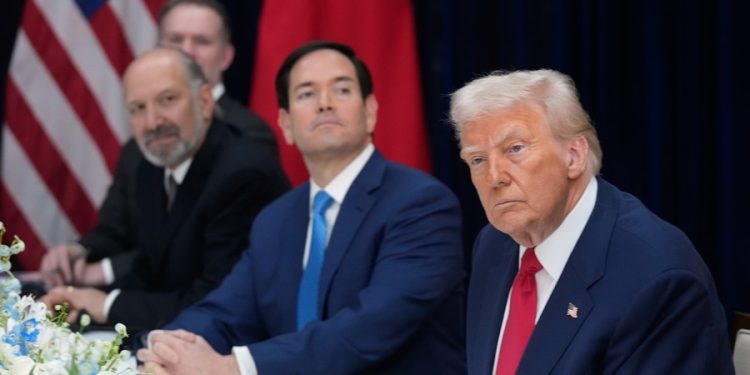President Trump’s off-the-cuff disclosure that he underwent an MRI scan is raising fresh questions about the secrecy surrounding Trump’s health and the need for presidents to be more transparent.
Trump is the oldest person to be elected president, and his aides and allies have long projected him as the picture of strength and vitality.
Outside physicians initially raised questions after Trump visited Walter Reed Military Medical Center earlier this month for what the White House described as a routine follow-up visit, though it was his second visit in six months.
A note from his physician pronounced Trump in “excellent overall health.”
Later, Trump disclosed that he underwent an MRI and a cognitive test during the secondary physical.
“I got an MRI, it was perfect,” Trump told reporters on Air Force One.
The president did not detail the reason for the MRI, and press secretary Karoline Leavitt later didn’t offer any additional details.
Jeffrey Kuhlman, who served as a White House physician to three presidents and wrote a book about his experience called “Transforming Presidential Healthcare,” said he wasn’t surprised a 79-year-old man needed a second checkup and that it’s typical for presidents to go to Walter Reed for advanced imaging.
“Most any procedure scope, I had the capabilities there at the White House. The only thing I couldn’t, that I’d have to Walter Reed for, is advanced imaging,” Kuhlman said.
But Kuhlman questioned the timeline of the treatment that was released by Trump’s physician Sean Barbabella. Aside from the MRI, other testing and preventive health screening could have been done in the White House doctor’s office in less than 15 minutes.
“It’s about an eight-minute helicopter ride from the South Lawn to Walter Reed. So we know that he at least had four hours available to undergo medical care,” Kuhlman said.
“There’s a disconnect there.”
It’s not unusual for an administration to be reticent about sharing a president’s personal health information, and there’s no legal requirement for an administration to be transparent about it.
Presidents throughout history have lied, deceived and covered up various ailments, however, and experts note there’s a tension between what a president wants to disclose and what the American people have a vested interest in knowing.
Former President Cleveland had secret surgery aboard a yacht to hide any reports of a cancerous tumor being removed from his mouth, and his administration and allies fought a leak by calling it fake news and discrediting the reporter.
Former President Wilson suffered a stroke in October 1919 that left him bedridden for the rest of his term, while his wife essentially served as acting president.
Former President Kennedy’s administration lied about his massive health problems, including the adrenal-gland disorder Addison’s disease.
Experts say there’s no incentive for anyone in the administration — let alone the White House physicians — to be truthful and transparent about the person who could fire them.
Former President Biden’s aides and allies have faced questions about whether they covered up cognitive decline, and Biden’s doctor released good health reports. Democrats ultimately pushed Biden to not run for reelection after a disastrous debate performance against Trump left them thinking he’d lose in part due to doubts about his health.
Biden has since been diagnosed with prostate cancer.
Trump’s medical history has been marked with secrecy, and critics have long accused him of trying to hide the true details of his health behind bluster.
Jacob Appel, a psychiatry professor at the Icahn School of Medicine at Mount Sinai and a presidential health historian, said the selective release of information, or filtering information through political spin, doesn’t serve the public interest.
If there’s a national security risk, or if the public doesn’t need to know, then there’s no reason to disclose anything.
“I think if you’re going to release some information, you want to release enough information that the public at least can put it into context. If you’re going to say that you’re having an MRI, we should know what the MRI is for,” Appel said.
“We don’t know what the MRI was for, because the President hasn’t even told us what body part was [scanned] … an MRI could be something to check for a cognitive issue. It could be something to check for a heart issue. It could be the president twisted an ankle and they’re afraid that he is a bone fracture. So it could be almost anything,” Appel said.
S. Jay Olshansky, a longevity researcher at the University of Illinois at the Chicago School of Public Health, said it’s important to understand the public only sees what the White House wants to release. Presidents are entitled to protected private health information just like the rest of the country, he said.
“It’s up to the general public to decide what they trust and what they don’t trust,” said Olshansky, who wrote a 2020 analysis of the health of both Biden and Trump
Most recently, Trump faced scrutiny after images had been circulating online of his swollen legs and a bruised hand covered in makeup. The White House eventually disclosed his diagnosis of chronic venous insufficiency, and officials said the bruise was caused by constant hand shaking.
When Trump was infected with COVID-19 in fall 2020, the administration initially hid the diagnosis, and then downplayed the severity without giving much detail about his treatment. Trump recovered after being granted special access to an unapproved drug to fight the virus.
In 2015, Trump released a letter from his then-physician Harold Bornstein that said he would be the healthiest president in history. Two years later, Bornstein admitted Trump dictated the letter himself.















